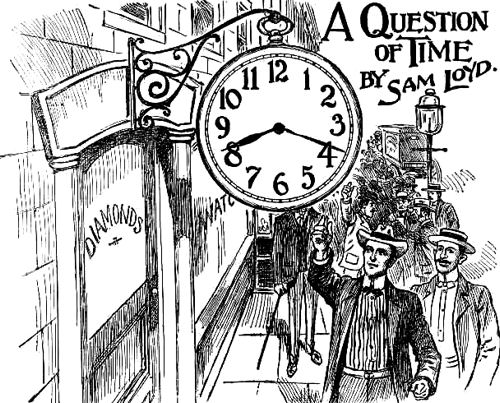



A CURIOUS paragraph has been going the rounds of the press which attempts to explain why the signs of the big watches in front of jewelry stores are always alike. They are painted upon the dial, apparently in a haphazard sort of a way, and yet they invariably indicate a certain number of minutes past eight. It cannot be attributable to chance, for it would tax one's credulity to believe that such a coincidence could occur all over the civilized world.
There is no accepted rule or agreement established with the jewelers or sign painters, for careful inquiry proves that few of them are aware of the fact or ever noticed that any two are alike, it would be a marvelous case of unconscious imitation if it is looked upon as a mere custom, accidentally following a pattern set by the originator of the device of the sign of a big watch. In London, where they take pride in such things, I saw several big watches, looking as if they had hung in front of the stores for countless centuries, all indicating the same mysterious time, accompanied by the announcement that the firms were established a couple of hundred years ago. I do not doubt for a moment that some such similar sign can be found at Nuremberg, where the watch originated during the Fifteenth Century.
The discussion seems to have brought out a recognition of the fact that from an artistic point of view, symmetry requires that the hands should be evenly balanced, as it were, on both sides of the face of the watch.
If they are raised too much there is a certain “exasperating, declamatory effect,” which is not altogether pleasing.
The time would be incorrect if the hands pointed at 9 and 3, and at other points would be too low, so, as a matter of fact, and from an artistic point of view, the position is well selected and is one of the points which, with the aid of a watch, can be shown to be possible. It is a fact however, that the mere puzzle of telling what time the watch indicates, has been held up to public gaze for all these centuries without being thought of or solved?
Take your watch and set it to the time indicated, with the hands at equal distances from the six hour, which shows it to he a possible position, and then tell what time of the day it is!
This is one of the many interesting puzzles which will be introduced to explain in a simple way several problems of the clock and divisions of time with which every one should be familiar.
How many boys know that a cord and stone will time a race more accurately than a $1,000 stop watch?
It is safe to say that few know that a watch can be used instead of a compass, or that with the aid of a compass you can set your watch correctly!
In giving the answer to the big watch puzzle, which was to tell the time of day always represented upon the signs in front of jewelry stores, I wish to correct a curious misapprehension which seems to have taken hold of the public mind. I was not surprised to find that almost every correspondent who vouchsafed an opinion on the subject stated that it was a well known fact that the time given upon the clocks was intended to represent the hour when President Lincoln was assassinated. This rumor originated from the fact that many public clocks were stopped at 7:22 a. m.. To represent the moment when Lincoln vital, but the official records show that he was shot at exactly 10:30 the night before. There is no connection, therefore, between the death of Lincoln and the time upon the sign clocks, which, as a matter of fact, was adopted several hundred years ago, for the sake of symmetry, and to give a convenient space for displaying the jeweler's name upon the dial. The exact time, as indicated upon those sign clocks, with the hands at equal distances from the figure 6, can only be 18 and 6/13th minutes past 8, or as it may also be expressed: 8 o’clock, 18 minutes, 27 and 9/13th seconds. It constitutes a puzzling little problem which many good mathematicians failed to master.
[Page 72]